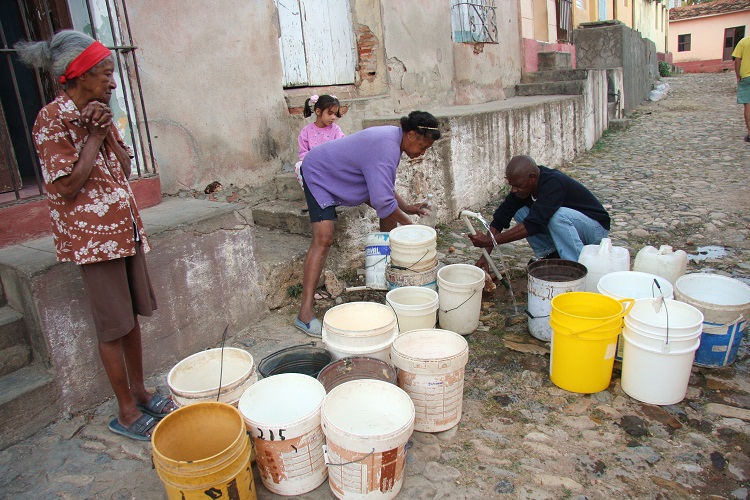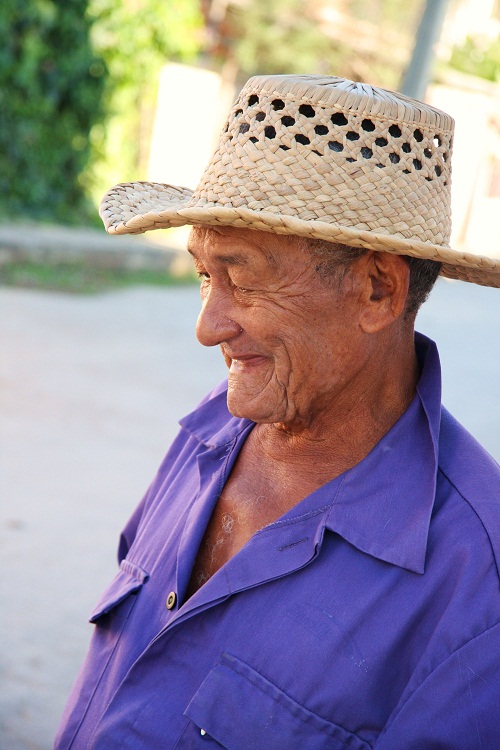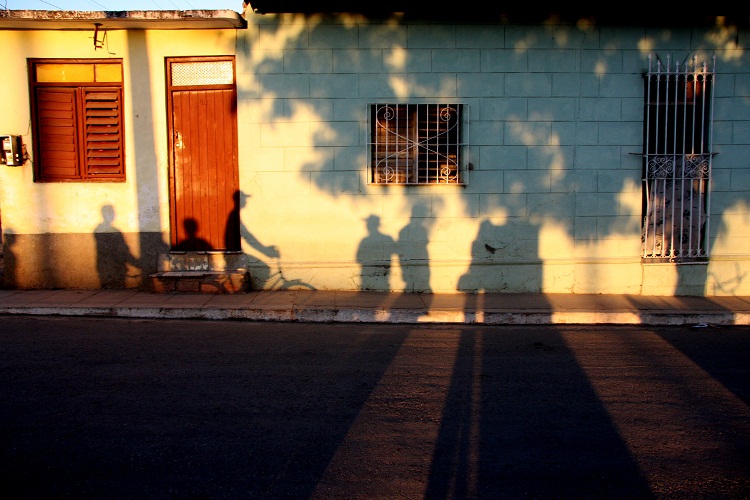Cuba’s Allium Heartland
Under the stars of night we hear the Palmas Reals, Cuba’s national tree, shake in the soft
winds; the agricultural landscape surrounding us is a secret for now. When day breaks,
and the tour begins, we see fertile valleys plowed into terraced rows, lush pinnacled
mountain summits and flowing rivers the color of honey.
Banao is known throughout the island as the garlic (ajo) and onion (cebolla) capital of
Cuba. Walking through the sloped fields of La Finca Chachi farmers explain to us the 8
different varieties of cebolla they have experimented with in past years. “Cebolla Caribe is
the most popular variety on the island,” says Chachi. “It’s smaller in size, but deep red and
delicious to cook with. The plot to the east is our seed plot, and by January 10 the white
onion flowers should be open and the whole field will be buzzing with bees.” Later in the
day at La Finca Higuanojo, farm manager ArleyEnrique teaches us about Banao’s unique
conditions for growing ajo y cebolla. First, the climate is very dry in the winter growing
season. Because of Banao’s mountain elevation, temperatures are cool in the night. The
rolling open hills, positioned at the foothills of the mountains, provide ideal air circulation
for the crops. Plots are cultivated and planted along the contours of these rolling hills
allowing for gravity-fed irrigation systems. River water is temporarily diverted to flood the
fields during irrigation days. As we drive north from the green fields into the town, Farmer
Aristides “Chachi” Leon points to a high pyramid summit and says, “Those mountains,
and the water they hold within, are what make Banao’s crops the sweetest in Cuba.”
Inspiring Land Care
Ismar Garce Palmero stands in a mulched pathway of a garden she knows well. Beyond
the garden’s small fence, diesel trucks rumble down the street and children walk home
with their friends. Ismar and her husband Roger Sonhesteson Anazeo manage a half-
acre urban permaculture garden in Sancti Spiritus – they are ambassadors for healthy
community living. The ecological design features of this garden, named El Ranchon
Permacultural Criolla, are seemingly endless: a plant-based grey-water recycling system,
vermiculture (composting with worms), a composting toilet for naturally fertilizing flowers,
mico-irrigation, rainwater catchment, groundwater filtration system with underground
irrigation for perennial plants, a riparian bio-reserve community of tadpoles, frogs,
songbirds and butterflies, thousands of row feet of nutritious greens, root crops, medicinal
and culinary herbs, ornamental flowers and a “vertical-gardening” experiment - and 85%
of their seeds are from on-farm seed production. We ask Ismar for a garden tour and
the first fifteen minutes we don’t take a single step. First she describes the importance of
maximizing maturation and structural diversity in an AgroEcosystem – the soon-to-be
harvested beets provide shade and water-conservation for the row of lettuce sown in the
understory. When the beets are harvested, it is time to transplant the lettuce seedlings.
Next Ismar harvests a large mustard leaf and describes the medicinal potency of this plant,
used to combat asthma; mustard is also a pest-deterrent for other garden plants. She tells
us to grown our own Collard greens because commercial producers use large amounts of
pesticides on this nutrient rich crop. Next she describes the garden’s system of Integrated
Pest Management, a form of organic pest control that uses diversity, flower intercropping
and other ecological methods to confuse and minimize problematic pest populations.
The amount of knowledge Ismar understands in one square foot of gardening space is
astounding.
“Twenty-five years ago,” says Roger, “people didn’t like the garden project at first. They
said our compost smelled bad. We had to educate.” The garden space, once a disco dance
club and then vacant for many years, took 25 days to build. Roger continues, “For the past
16 years we have used no chemicals, for 8 years no animal manures. How do we keep our
garden so healthy? Biodiversity and worm compost humus. We recycle over 100 tons of
organic matter per year and we make the garden a busy place, where nature’s interactions
take over. The garden becomes a symbol of the human ability to co-create something with
nature – beauty, community and sustenance.”
Organoponicos and Urban Farming
Organoponico is a Cuban term for organically grown, bio-intensive, hand-cultivated
urban and suburban gardens, often built with raised beds above cement, on top of
previous building sites or on soil previously inhospitable to food production. Through
bio-remediation techniques such as worm composting, soil bacterium inoculations and
composting, soil material is created organically, enabling the growth of healthy and greatly
productive gardens. One of the most important aspects of Organoponicos is that food
production is located within urban populations, meaning that less energy is required to
transport the harvests to the people, which greatly increases food security and healthy diets
for the city dwelling population – where 75% of Cuba’s 11 million residents live.
The Alamar Vivero Organoponico is a seemingly endless urban farm of 11 hectares
farmed collectively by over 175 people. The gardens, which beam with a green vibrancy
only healthy soil can produce, are situated east of La Habana and were founded in 1995
during the height of the Special Period by current (democratically elected) Farm President
Miguel Salcides. On our first visit to Alamar, Salcides outlined the unique characteristics
of this Organoponico. “Here at Alamar, our main goal is to support and encourage the
culture of agriculture. In the 21st century, and (he laughs) even in Cuba, we have all the
knowledge and infrastructure design to create ecologically sustainable food systems. All
over the world, we know the scientific methods of organic growing. The most challenging
component of the Agroecosystem is the Human Factor.” Indeed, it is society who decides
who eats, what we eat, if we use chemicals or genetically modify seeds, and who will be the
future farmers. He continues, “Our first goal is to provide a healthy social environment for
our farmworkers. This component is key to long-term farm sustainability.” Miguel goes on
to list their Farmworker Rights Statement: Dignity, Possibilities for Advancement, Healthy
Work conditions (6 hours max work days in summer, 7 in winter), Economical Base Salary,
On-Farm lunch and Breakfast for Free, Free Barbershop, Toothpaste and Basic Toiletries.
The second goal of Vivero Alamar is to raise the farmworker’s livelihoods by exploring
diverse AgroEcological markets and ideas for economic advances. “We have many
challenges – and some of our ideas for diversifying farmer activities include: agro-tourism,
on-farm restaurants and dining, educational training delegations, production of biological
fertilizer and bio-pest control products and intellectual services. This is how we are
advancing in the AgroEcology realm: Intellectual Discipline.”
A third and integral part of the solution for increasing local food security and
strengthening community is Education. As we walk away from the vibrant, lively
fields of Vivero Alamar Organoponico, I have a new perspective on what the Cuban
Agricultural Movement has to teach the world. Here’s the message from the Cuban
AgroEcologists we have met so far: It is the Human component of agriculture that seeks
and needs advancement. Through education, populations will understand the integral
role of nutrition to long-term personal health care and well-being. Through education,
people will understand how to play active roles in responsible community activism.
The AgroEcological Movement of the 21st Century is a Social Movement. The key
factor in creating a just and sustaining future is education, inspiration and passionate
encouragement for the next generation of caretakers. Hope is in the seeds of intellect,
creativity and friendship, planted in the Heart’s of the Youth.






























